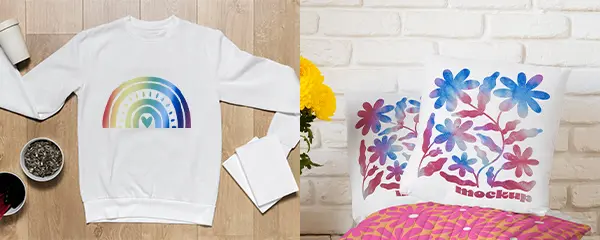
DIY Water Transfer Home Decor Projects
2024-10-11
2024 Canton Fair – October, Autumn Invitation
2024-10-18Infusible Ink transfer sheets is a game-changer in the world of personalized crafting. It offers stunning, vibrant, and long-lasting results, making it a top choice for anyone looking to create professional-grade projects at home. However, like any specialized material, Infusible Ink works best on certain surfaces. To get the best results, it’s important to know what types of materials are ideal for this innovative ink. Below, we’ll explore the best surfaces for Infusible Ink and provide you with a detailed understanding of how to achieve flawless results every time.
What is Infusible Ink?
Infusible Ink transfer sheets is a unique crafting material, known for its ability to bond permanently with compatible surfaces. Unlike traditional iron-on vinyl, Infusible Ink actually becomes part of the material it is applied to, resulting in vibrant, high-quality designs that won’t peel, crack, or fade over time. This is because the ink infuses into the surface, creating a seamless, smooth finish.
Materials That Work Best with Infusible Ink
To achieve optimal results, Infusible Ink requires specific types of surfaces. These surfaces must be able to withstand high heat and have a chemical composition that allows the ink to bond permanently. Let’s break down the best materials to use with Infusible Ink.
Polyester-Based Fabrics
Polyester is the go-to material for Infusible Ink. This is because polyester allows the ink to bond permanently, providing bright, bold colors and a professional-grade finish. Here’s why polyester is the best choice:
Durability: Polyester fabric is heat-resistant and durable, making it ideal for projects that require high temperatures to transfer the ink.
Vibrancy: The colors on polyester are incredibly vivid due to the material’s chemical composition, which allows the ink to fuse deeply into the fibers.
No Cracking or Peeling: Since the ink becomes part of the polyester fibers, the design remains smooth and seamless. There’s no risk of it peeling, cracking, or fading over time.
When working with fabrics, aim for 100% polyester or at least fabrics with a high polyester content (e.g., 70% polyester or higher). Lower polyester content may result in dull or inconsistent transfers.
Blended Fabrics (Polyester/Cotton)
If you’re set on using a blended fabric, you can still get good results with materials that are at least 65% polyester. Blends that have a lower polyester content (below 65%) may not hold the ink as well, leading to faded or uneven designs.

infusible ink fabrics
Sublimation Blanks
Infusible Ink works similarly to sublimation printing, so it performs exceptionally well on sublimation blanks. These blanks are materials coated with a polymer layer, which allows the ink to bond permanently. Common sublimation blanks include:
Sublimation mugs: These mugs are coated with a polymer surface, allowing you to create custom designs that are dishwasher-safe and long-lasting.
Keychains and Ornaments: Made with polymer-coated materials, these items are great for personalized gifts or holiday decor.
Sublimation pillows and cushion covers: For home decor, using sublimation-ready pillows made from polyester ensures your designs stay vibrant over time.
Ceramics
Certain ceramic products, when coated with a polyester-based layer, work beautifully with Infusible Ink. The heat required for transferring Infusible Ink makes ceramic a durable option for items like:
- Ceramic coasters
- Mugs
- Plates
The key to success with ceramic surfaces is ensuring they are coated with a sublimation-friendly surface to allow the ink to fuse permanently.

infusible ink blanks
Materials to Avoid with Infusible Ink
Not every surface is suitable for Infusible Ink. Here’s a quick list of what not to use:
100% Cotton: While great for regular iron-on projects, cotton won’t hold Infusible Ink well. The designs will be faded, and the ink won’t properly bond to the material.
Nylon: This fabric doesn’t react well to the heat required for Infusible Ink transfers and could even melt!
Untreated Ceramics or Wood: Unless these surfaces have been coated for sublimation, the ink won’t fuse properly.
How to Prep Your Materials for Infusible Ink Success
Once you’ve picked the right material, it’s time to prep! Here’s a quick step-by-step guide:
Pre-wash your fabric: Especially for garments, pre-washing helps remove any debris or chemicals that could interfere with the transfer.
Use a lint roller: Remove any dust or particles from the fabric or surface before applying your Infusible Ink transfer.
Preheat the surface: Lightly warming up the material before applying the design can help ensure a smooth transfer.
Use heat-resistant tape: Secure your transfer sheet with tape to keep it in place during the pressing process.
Apply even pressure: When using your heat press, apply consistent pressure for the recommended time. This ensures the ink bonds evenly.
Troubleshooting Common Infusible Ink Issues
Even when you’ve chosen the perfect material, things don’t always go according to plan. Here are some common issues and how to fix them:
Faded designs: This often happens if the polyester content is too low or if the heat press wasn’t hot enough.
Uneven transfers: Make sure to use consistent pressure across the entire surface to avoid patchy designs.
Colors bleeding: Overheating or using the wrong material can cause colors to bleed or blend together.
So, what material is best for Infusible Ink? If you’re after vibrant, long-lasting designs, polyester is your best friend! Whether you’re using fabric or specialty blanks, the key is to choose a material that allows the ink to bond deeply. Stick to polyester or sublimation-coated surfaces, and your Infusible Ink projects will look professionally made, no matter your skill level!
Related:
Everything You Need to Know About Infusible Ink Transfer Sheets
Can You Use Infusible Ink on Sublimation Blanks?
Infusible Ink Transfer Sheets for shirts

